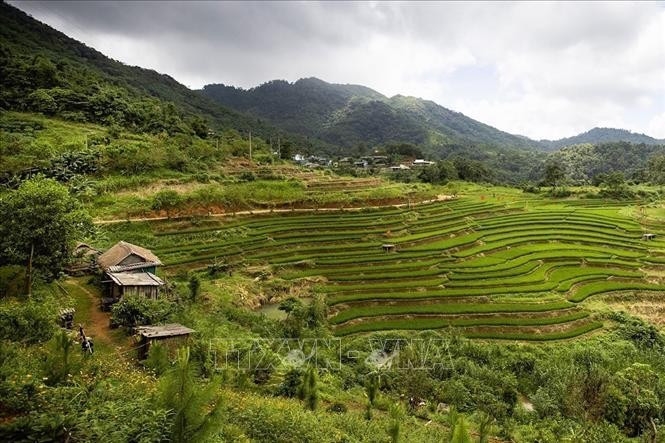An untapped gem awakened
Located at an altitude of over 600m above sea level, Mung hamlet is home to the Muong people. The area enjoys a cool climate year-round, with pristine landscapes of ancient forests, terraced rice fields, and gentle hillsides. The local community primarily relies on maize, cassava, and rice cultivation, as well as harvesting forest products.
Since 2021, under the guidance of local authorities, Mung hamlet has embarked on a transformation journey, positioning itself as a promising destination in Cao Phong commune, Phu Tho province (formerly Cao Phong district, Hoa Binh province).
    |
 |
|
The stunning terraced fields in Mung hamlet of Cao Phong commune, Phu Tho province |
Colorful flower fields now flourish on terraced slopes, hillsides, and village paths, earning Mung hamlet the reputation of a “flower paradise” that draws young travelers, photographers, and visitors from near and far.
Duong Diem Quynh, a tourist from Hanoi, said the landscape is even more beautiful than she imagined. The flowers are in full bloom, the weather is refreshing, and the Muong cuisine is both delicious and distinctive. She said she will come back with friends.”
Beyond its natural terraces, Mung hamlet boasts 520ha of strictly protected natural forest, serving as a precious “green lung” ideal for eco-tourism, trekking, and outdoor activities.
Along the route to Mung hamlet, travellers can also visit nearby attractions such as Dau Rong (Dragon Head) mountain, the Vietnam Scientists Heritage Park, and enjoy Cao Phong oranges, a speciality of this scenic land.
Tourism linked with cultural heritage
Mung hamlet also captivates visitors with its rich Muong cultural traditions. In 2023, the commune officially launched a community- and eco-tourism model in Mung hamlet, attracting investment in homestays and cultural experiences.
Nguyen Van Hai, owner of Thung May Wellness Retreat, noted his desire to offer travelers authentic experiences of Muong landscapes and culture, while creating local jobs and boosting the regional economy.
Tourists to Mung hamlet can witness seas of clouds at dawn, visit orange orchards, taste Cao Phong oranges straight from the garden, stay in traditional stilt houses, and savour local dishes such as hill chicken, native pork, bitter bamboo shoots, and bamboo-tube rice. Evening activities include campfires, bamboo pole dancing, and gong performances with the Muong community. Homestays also provide team-building, trekking, and cultural exploration services, making the destination suitable for families, groups of young people, and nature lovers alike.
According to Nguyen Linh Ngoc, Deputy Director of the Phu Tho Department of Culture, Sports and Tourism, the Muong Thang cultural identity, with its stilt houses, gong culture, folk songs, cuisine, and attire, represents invaluable assets for tourism development. She emphasised the need to improve infrastructure, high-quality accommodation, and diverse experiences, while strengthening branding and tour linkages with other destinations in Phu Tho and the Northwest region.
Hoang Minh Hieu, Chairman of Cao Phong commune, stressed that with over 98% of residents being Muong, Mung hamlet embodies the essence of Muong Thang culture. Local authorities are determined to develop the village into a compelling community tourism destination, where natural beauty, cultural heritage, and the warmth of local people together foster green, sustainable tourism and improved livelihoods.
Source: VNA